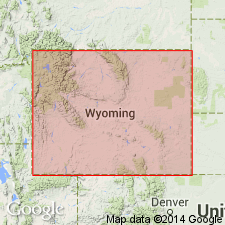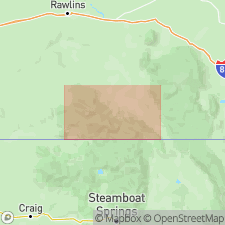
- Usage in publication:
-
- Encampment River Granodiorite
- Modifications:
-
- Named
- Geochronologic dating
- Dominant lithology:
-
- Granodiorite
- AAPG geologic province:
-
- Northern Rocky Mountain region
Summary:
Named for exposures in gorge of North Fork of the Encampment River, Carbon Co, WY, Northern Rocky Mountain region. Forms outcrops along the continental divide south of Battle Lake. No type locality designated. Is a moderately to well foliated, medium-grained granodiorite consisting of 1 to 3 mm anhedral grains of perthite, oligoclase, and quartz set in an intergranular matrix of quartz, oligoclase, microcline, biotite +/-calcite +/-epidote +/-chlorite, and +/-sphene. Detailed petrologic description. Chemical data. The matrix is granitoid with polygonal or irregular xenomorphic grains, suggesting rapid simultaneous crystallization. Xenoliths derived presumably from Green Mountain Formation (new) and northern Archean gneiss complex are common near the continental divide. Dikelets of granodioritic material intrude the Green Mountain Formation along North Fork of Encampment River. Geologic map. Is the oldest of the post-sedimentary Proterozoic intrusive rocks. Is older than the Sierra Madre Granite (new). Of Proterozoic age; has a probable age of 1980 m.y. Isotopic data.
Source: GNU records (USGS DDS-6; Denver GNULEX).

- Usage in publication:
-
- Encampment River Granodiorite
- Modifications:
-
- Overview
- Geochronologic dating
- AAPG geologic province:
-
- Northern Rocky Mountain region
Summary:
Is a single pluton and the oldest unit in the Sierra Madre, WY, Northern Rocky Mountain region that lies south of the east-west trending boundary between two Precambrian provinces. Probably derived by partial melting and remobilization of a polycyclic quartz biotite gneiss. Has two discrete isochrons--one of 1,980 +/-70 m.y. and a second of 1,660 +/-85 m.y. Two events suggested, the initial event and a metamorphic event. Geologic map.
Source: GNU records (USGS DDS-6; Denver GNULEX).
For more information, please contact Nancy Stamm, Geologic Names Committee Secretary.
Asterisk (*) indicates published by U.S. Geological Survey authors.
"No current usage" (†) implies that a name has been abandoned or has fallen into disuse. Former usage and, if known, replacement name given in parentheses ( ).
Slash (/) indicates name conflicts with nomenclatural guidelines (CSN, 1933; ACSN, 1961, 1970; NACSN, 1983, 2005, 2021). May be explained within brackets ([ ]).

